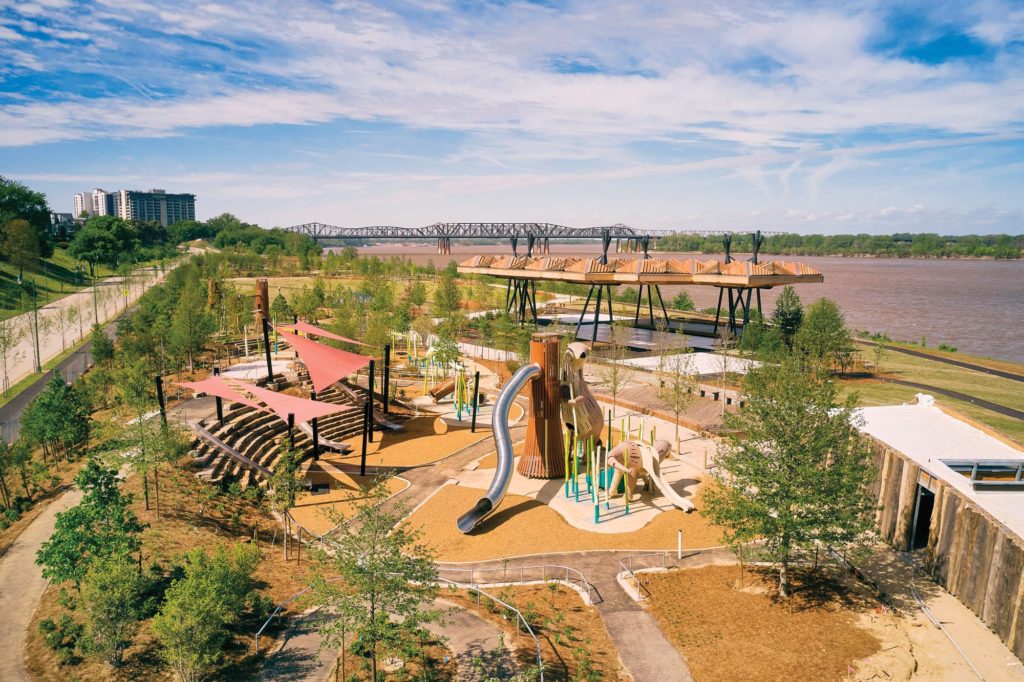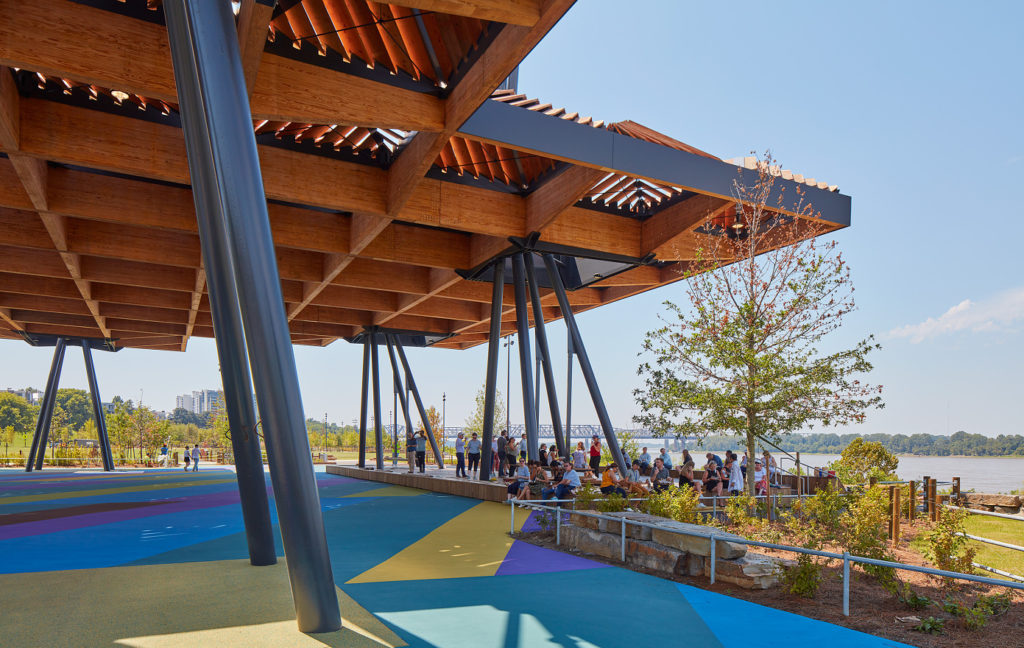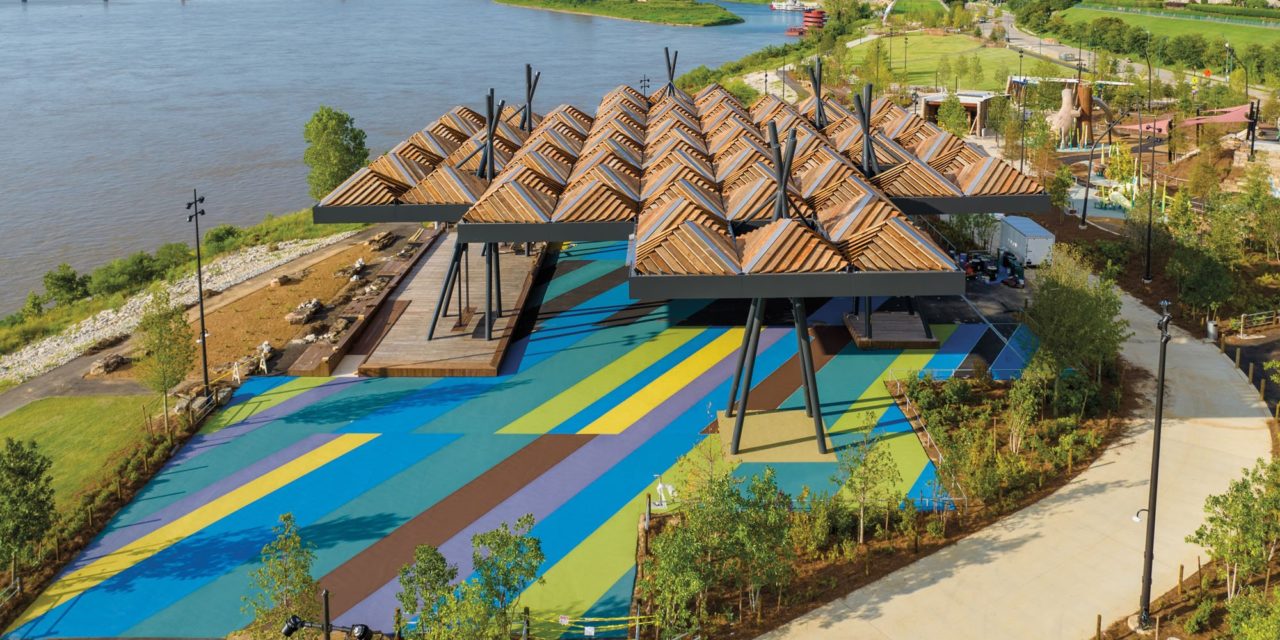Two key reasons why I have so relentlessly advocated for Tom Lee Park to be transformed from a pasture into a park for 14 years are: 1) the barren, bleak spot was a profligate use of Memphis’ most valued 31 acres, and 2) the power of a park setting national standards to have a significant impact on the city’s national brand.
Both of these have been achieved and then some, but best of all the positive impact on the Memphis brand – at a time when it needs that kind of national publicity – has been consistently positive and positions the city as ambitious, bold, forward-looking,
Reviewing the media coverage of the past two months, it has been uplifting to read something that positions Memphis in such a positive light instead of the growing narrative of a city in distress.
Here’s a sampling of the national coverage:
New York Times:
A Reinvented Park Along The Mississippi River – https://www.nytimes.com/2023/08/31/arts/design/products-events-people.html
Developed by the Memphis River Parks Partnership with a masterplan and architecture by Studio Gang and landscape by SCAPE, the reinvention transforms a barren swath of patchy grass into an environment animated by native plantings and trees.
James Little, a Memphis-born artist who is known for his precise works of geometric abstraction translated a painting he created in 2017, called “Democratic Experiment,” for the surface below and around the canopy. The new artwork is a vibrant composition of diagonal bars in shades of blue, green, burnt umber, mustard yellow and chartreuse.
“At first, I had an issue with the idea of people coming out and playing basketball on top of my image, but I had to get over that,” Mr. Little said. The 71-year-old artist is based in New York and received a late-career boost last year, when he was represented in the Whitney Biennial, a plum that had eluded him for more than four decades.
The 20,000-square-foot pavilion artwork helped him confront his fear of doing work at a very large scale, he said. And he is now embracing the interactive and democratic nature of the project, which brings art to citizens who may not typically visit museums. “The piece is something that no one should feel uninvited to — it’s literally for the people,” he said.
Fast Company:
This $61 million riverfront park turns Memphis into a natural wonderland
https://www.fastcompany.com/90947548/this-61-million-riverfront-park-turns-memphis-into-a-natural-wonderland
In Memphis, Tennessee, a remarkable new public park has just opened. Filling 30 acres along the edge of the Mississippi River with active, social, ecological, and architectural spaces, it could reframe the city’s fading connection to the riverfront. It could also set a new standard for what waterfront parks can do…
The new park is a dramatically reconfigured space, its broad open lawns supplanted with native ecological systems, recreational areas, birding sites, and river-inspired circulation paths winding through 1,000 new trees, public art, play areas and a large shade canopy and event space…
Access is a major focal point of the design, which had to contend with the park’s location below a tall bluff. Ramps and cutbacks traverse this divide, and were used as opportunities to celebrate the river’s geological force while drawing the city’s neighborhoods in. Stretching a mile-and-a-half along the river’s edge, the park is a $61 million effort to reconnect Memphis to a natural asset that has been largely ignored or actively avoided. Though it was nearly sidelined by a contentious opposition movement, the project is leading a social and ecological transformation at what could become the city’s new front door.
Metropolis:
Tom Lee Park Mixes It Up
https://metropolismag.com/projects/tom-lee-park-mixing-it-up-in-memphis/
Located on the Mississippi River waterfront, the park is part of a plan to help different classes, communities, and histories commingle.
Working with landscape architecture collaborator SCAPE, Studio Gang designed a switchback pathway that cuts back and forth down the bluff, making its main entrance accessible from above. A misting multicolored light-and-water feature marks the entry at one end of an existing pavilion’s rolling green roof. Asphalt and wooden paths are interwoven with pollinator gardens, widening at two junctures into lawns left open for the annual barbecue and blues festivals.
Two dedicated buildings for food and drink vendors evoke the site’s industrial heritage with curving compositions of standing logs. An expansive wood-and-steel-beam pavilion with slits at the top and a mural beneath protects basketball courts and eating and drinking areas from sunlight and rain and frames views of the bridges. Nearby, an extensive, colorful playground by MONSTRUM is made up of custom-designed play equipment referencing native creatures of the Mississippi River…
The goal, ultimately, is to make the park into one of those “third places” outside of the home and office where, in a society stratified more than ever by income levels and political ideology, social mixing happens across differences. “That is the goal: to break down the divides that are inherent in places like Chicago and other cities, where there are areas where you don’t feel welcome,” Gang says. “In a city like Memphis that is not used to using the waterfront as a place to go, there’s a huge hurdle to get over.”
Wallpaper:
Tom Lee Park reimagines Mississippi banks into a lush public space in Memphis
https://www.wallpaper.com/architecture/tom-lee-park-studio-gang-scape-studio-memphis-usa
 Tom Lee Park is a lush new public space that transforms the banks of the Mississippi river in Memphis – Tom Lee Park unfolds along the east bank of the Mighty Mississippi.
Tom Lee Park is a lush new public space that transforms the banks of the Mississippi river in Memphis – Tom Lee Park unfolds along the east bank of the Mighty Mississippi.
This is an important, new, green space for downtown Memphis, as well as a place where nature and the city meet. Its creators, Chicago based Studio Gang (the project’s masterplanner and architect) and New York’s Scape (who acted as landscape architect and park designer), describe the old site as a ‘working waterfront’, a previously flat, inhospitable, landfill part of town used for anything between parking lot, dump site, commercial transport route and industrial facility. The team, led by respective founders Jeanne Gang and Kate Orff (both featured in the Wallpaper* USA 300), was called upon by client Memphis River Parks Partnership to reimagine this stretch of the riverside as a centrepiece riverfront green, an urban lung and open space to be shared among Memphis residents…
Thousands of Memphians were invited to participate in a series of consultation and public engagement activities to record the people’s needs, wishes and worries, in order to craft the space in the best way possible for its users. This project had to be as sustainable and resilient as possible as a key priority, in order to carve a strong sense of community in it. The design was further informed by the Youth Design Leadership program, which embedded local teens in the design process (in partnership with local nonprofit KnowledgeQuest).
The designers worked to add texture and articulation to the site, by creating sequences of open lawns and more enclosed garden sections, bringing grading and physical dynamism through form and an undulating terrain. Gang explains that they studied the aerial shape of the Mississippi, looking at its natural, winding body, and used it as a reference point for their design. Then, they began to overlay activities – from playgrounds to sheltered resting spots, and multi-use areas for sports and performances. Public amenities now include fitness stations; a playground created together with Denmark-based specialists, Monstrum; two passively cooled structures for food, drink and restroom facilities; and the park’s signature Sunset Canopy, a flexible shelter defined by a 2O,OOO sq ft floating timber roof placed upon a series of six steel ‘quadpods’ – their shape and arrangement, a nod to the historic site’s traditional cranes. Everything is made predominantly of wood (with some steel elements, due to the area’s earthquake prone nature), in particular simple logs. It included a few firsts for Gang, such as the studio’s first battered construction of its type and scape, and its largest ever canopy.
Arch Daily:
Transformed Tom Lee Park: Studio Gang and SCAPE Architects Revitalize Memphis Riverfront
https://www.archdaily.com/1006434/studio-gang-and-scapes-riverfront-transformation-opens-to-the-public-in-memphis
At its core, the design aims to strengthen the connection between downtown Memphis and the river. It offers the first accessible access to the river, compliant with the Americans with Disabilities Act (ADA), at the Cutbank Bluff. Additionally, it provides safer pedestrian crossings at Vance, Huling, and Butler Streets on Riverside Drive.
The park features three newly constructed pavilions crafted from timber, taking inspiration from the industrial structures that once existed along the riverfront. Combined with fresh landscaping elements and a river-themed playground designed by Monstrum, these structures serve as enticing destinations for various activities, such as recreation, outdoor education, dining, and performances. They enhance these experiences against the backdrop of the vibrant Mississippi River.
Instead of the previous flat lawn, the park now boasts rolling hills adorned with native plants and trees, creating spaces inspired by the dynamic nature of the Mississippi River. These areas are divided into four zones, each with a unique character ranging from civic and recreational to contemplative. They accommodate a wide range of activities and provide a habitat for native birds and pollinator insects that migrate along the Mississippi Flyway Corridor.
At the heart of the park is the Sunset Canopy, a 16,000 sq ft timber structure supported by steel columns, protecting the park users from sun and rain. The canopy is the architectural centerpiece of the design, hosting community activities and year-round events, including basketball, fitness classes, dance lessons, and concerts. On the ground level surface, it boasts a multi-colored, geometrically patterned court designed by artist James Little, who was born and raised in Memphis.
The Art Newspaper:
Installations by Theaster Gates and James Little reinvigorate riverfront park in Memphis https://www.theartnewspaper.com/2023/09/25/theaster-gates-james-little-memphis-tom-lee-park
On 31 acres of prominent Memphis real estate bordering the Mississippi River, Tom Lee Park reopened on 2 September after a $61m investment and six years of planning and work by the architectural firm Studio Gang and park designer Scape. Besides 1,000 new trees and a greatly enhanced landscape for people and pollinators, two new permanent public art installations by Theaster Gates and James Little are being unveiled—each aiming to create sites for the community to come together, in play and contemplation.
Gates answered the call with A Monument to Listening (2023), including 32 dark basalt pillars carved into throne-like sculptures. He has configured 28 of these in radiating concentric circles, with the four other sculptures nearby at the water’s edge joined by a taller throne as a stand-in for Lee overlooking the river.
“Memphis lives between a very Black world and a very white world, and is a place that’s always held a bit of tension around who deserves the right to gather,” says Gates, whose family always stopped in Memphis as the midpoint on trips from Chicago to Humphreys County, Mississippi, to visit relatives.
tension around who deserves the right to gather,” says Gates, whose family always stopped in Memphis as the midpoint on trips from Chicago to Humphreys County, Mississippi, to visit relatives.
The Memphis River Parks Partnership collaborated with the non-profit organisation Project Backboard to work with Little, the New York-based painter born and raised in Memphis, on a second site-specific commission. It spans the surface of a full basketball court and two half courts under a soaring outdoor pavilion designed by Studio Gang called Sunset Canopy.
“Basketball courts are like training grounds for citizenship where a group of strangers from a community can shoot hoops and solve a problem together in a public space,” says Daniel Peterson, the founder of Project Backboard, which works with artists to create works on basketball courts.
World Architects:
Tom Lee Park Opens
https://www.world-architects.com/en/architecture-news/headlines/tom-lee-park-opens
With its experience designing buildings along the Chicago River, among other water-based projects, Jeanne Gang and her Chicago studio were hired by the partnership to develop the Memphis Riverfront Concept for six miles of the city’s Mississippi riverfront. Tom Lee Park was just one of five “zones” in the plan Studio Gang delivered in 2017. The concept’s overarching principles were to foster civic pride and identity in the majority Black city, restore natural conditions and native ecologies along the river, and better connect the green spaces to the city.
That the park is named for a Black man who selflessly put his life in jeopardy to save others, rather than as it was for businessman John Jacob Astor, is certainly important in terms of Memphis’s identity. So was the removal of two Confederate statues from its downtown parks in 2017, the same year of the Memphis Riverfront Concept. Those parks were transformed as part of the partnership’s plan into River Garden and Fourth Blu Park. Respectively completed in 2018 and 2019, they were precursors to the reimagined Tom Lee Park, which features contributions by Chicago artist Theaster Gates and Memphis native James Little that further the plan’s goal of fostering civic pride and identity.
Architectural Record:
With Tom Lee Park, Studio Gang and Scape Transform a Bedraggled Memphis Park into a Riverfront Destination
https://www.architecturalrecord.com/articles/16404-with-tom-lee-park-studio-gang-and-scape-transform-a-bedraggled-memphis-park-into-a-riverfront-destination
“It was a flat, sort of washed-out lawn, compacted to the degree that it was almost like concrete,” says Kate Orff, founding principal at landscape architecture and urban-design studio SCAPE, of the near-treeless park. She describes it as being frequented by “hard-core joggers at sundown,” but devoid of places for people to gather, save for a few benches. Notably, the park was also without soil and significant animal life in an area known as a key stopover point for migratory birds traveling along the Mississippi flyway.
Now, in what is the second collaboration between SCAPE and Studio Gang to be completed this year, following their revamp of the Arkansas Museum of Fine Arts in Little Rock’s MacArthur Park, Tom Lee Park has emerged from a $61 million renovation as not only a proper park, replete with lush native vegetation (including 300 oak trees) and myriad opportunities for active and passive recreation, but an impressive public space worthy of its fabled namesake.
***
Join us at the Smart City Memphis Facebook page and on Instagram for daily articles, reports, and commentaries that are relevant to Memphis.




